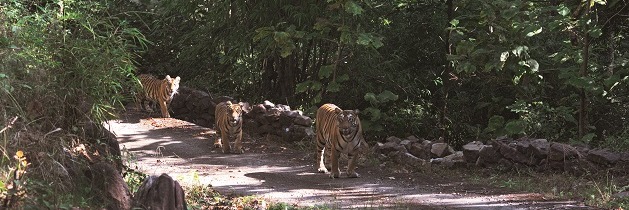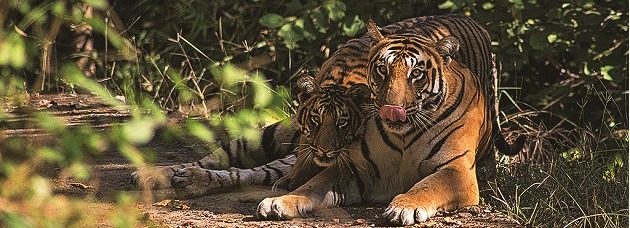Encounter with Lady and Luck
First published in Sanctuary Asia,
Vol. 35
No. 2,
February 2015
By Shashank Birla
As dawn broke over the Churna Forest Rest House in the Satpura National Park, Madhya Pradesh, we made ready to go. During our time here, we had spotted a wealth of birdlife including the Indian Eagle-owl, Scarlet Minivet, Yellow-footed Green-pigeon, as well as mammals such as sloth bears, gaur, Indian giant and flying squirrels among many others.
During the planning of this wonderful trip (with the help of Jungle Lore, a specialised wildlife travel agency), I had wondered, “Would one of Satpura’s enigmatic tigers bless us with a sighting?”
And we had been lucky the previous day’s evening. On the advice of our guide, Rameshwar, we sat patiently at a point on the track closest to where he had earlier seen a tigress with two young ones. Minutes passed and we began to wonder whether anything would come of our patience. Then, deep within a Lantana outcrop, we saw movement. The orange was unmistakable! It was a cub and after a few sips of water, it disappeared, keeping the ghostly reputation of Satpura’s tigers alive. Happy to have seen the cat, we headed towards Churna, and soon came across the tracks of a big male, identified as Sidhu, by our guide who informed us that he had been relocated from Bandhavgarh.

On the sunlight-dappled forest road, the tigress walks towards the author’s vehicle, followed by two of her cubs. Photo Courtesy: Shashank Birla

Sidhu, the resident male tiger, had traversed the same route as the one taken by the author and his companions on that fateful morning. Unfortunately, his pugmarks revealed that he went in the opposite direction as them. Photo Courtesy: Shashank Birla
Tiger Bonanza
Aly Rashid, owner-naturalist at Reni Pani Jungle Lodge and the man responsible for our amazing trip so far, had a quiet optimism about him on that morning drive. It was cold and my wife, Deepi and I, adjusted our caps and mufflers against the chill. An hour into the drive, we noticed that Sidhu (the male tiger) had used the same path late last night, but headed in the opposite direction as us this morning. No alarm calls, no signs. Nothing. Our hopes of seeing a tiger again were melting away as the sun rose higher. As a last ditch effort, we reached the same spot where we had seen the cub earlier, and waited patiently.
We were the lone jeep; this park allows only 12 vehicles in at a time, and not everyone chooses the Churna trail, which is a fair bit longer than the Madhai route. Complete silence. Then suddenly, we heard rustling deep within the undergrowth. They were still here! Deepi pointed to a quick movement, and our driver Rakesh spotted a cub sprint behind the bushes. Aly and Rameshwar spotted the second and for a few sublime seconds, we all also saw the mother on an opposite ridge before she disappeared. Langur alarm calls could now be heard further up the hillside and we assumed that they would walk away from us. At this point, Aly suggested we get off the main road and just park around the bend. That way we’d still have a good idea of where the alarm calls were originating, and we would not be blocking their path in case they decided to change their mind and walk along it. The calls subsided, followed by silence. We still waited. Then, 10 minutes later, we once again heard rustling, twigs breaking, and then a loud ‘thump’! Cautiously, we rounded the bend and there, larger than life, was our tigress, not 10 m. from us, bang in the middle of the road!
Aly and I clicked away, as the contented mother sat yawning in the late morning sun. Soon, we saw movement, and the first cub popped its head out from behind her. He walked boldly forward and nuzzled his mother giving us a moment of pure delight as he crouched protectively next to her. Minutes later, the second cub entered the scene and we smiled, happy that we had finally seen the whole family. Or had we?
Rameshwar gasped and exclaimed excitedly “Teen hain!” as he peered through the binoculars. No one, including the Forest Department, had heard of a third cub! Our surprise quickly changed to alertness, as the mother began walking… toward us!
A special Satpura family
We were a touch unsure of what her behaviour meant since Satpura tigers are not nearly as habituated to humans and jeeps as their counterparts in Kanha, Corbett,or Ranthambhore.
We carefully reversed the vehicle to give the mother and cubs the right of way, but we were on an incline and for a fraction of a second the vehicle lurched forward towards them!

A streak of tigers walk past the author’s vehicle, revealing that the adult tigress is the mother of not two, but four cubs! No one, not even the Forest Department, had any idea her family was so large. Photo Courtesy: Shashank Birla
Her demeanour instantly changed, her body tensed, and she lowered herself into a half-crouch! We had wanted to offer her the right of way, and ended up achieving the opposite. Mercifully Rakesh kept his cool, moved the vehicle into 4-wheel mode and managed to move back to the Jhinjhini Mahal junction (where we were earlier parked), leaving the main road open for the feline family. The tigress got the message. She relaxed her stance and walked calmly past us, followed by her… wait, what? Four cubs!
Rameshwar was beside himself with joy, as we all stared in awe. No one in the park had any idea of the existence of this large family, which speaks volumes for the secret life of tigers. No one had any recollection of the last time that five tigers had been spotted together in the Bori-Satpura Tiger Reserve.
Unfazed by our excitement, the tigress continued along her path, casually spray-marking the trees, her 10-month-old cubs, nearly leopard-sized, obediently followed.
Tourists can help
No one spoke a word on the return journey. Even the three dholes (wild dogs) that zipped across the road were sort of taken in our stride. Deepi had a broad grin on her face and we returned to the Madhai camp in great spirits as we shared the news with forest officials, who reacted happily as one might when informed of a birth in the family! Her markings confirmed she was a resident tigress, born in Satpura who had been seen mating two years ago. She had not conceived then, but had more than made up with this baby boom.

In their first clear sighting, the tiger watchers observed as the mother, stretched out across the road, was joined by the first of her cubs. The young male nuzzled against her before settling down at her side. Photo Courtesy: Shashank Birla
Fact File
Satpura Tiger Reserve, Madhya Pradesh: This1,427 sq. km. highland ecosystem is still off the radar of most wildlife tourists. Other than tigers, with luck on their side, visitors can also sight sloth bears, dholes, leopards and otters. The reserve comprises the Pachmarhi Wildlife Sanctuary, the Satpura National Park and the Bori Wildlife Sanctuary.
Travel: The closest rail heads are at Itarsi, Sohagpur or Pipariya. The nearest airport is in the city of Bhopal that is just 170 km. away.
Stay: Reni Pani Jungle Lodge, www.renipanijunglelodge.com
Forsyth’s Lodge, www.forsythlodge.com
Both lodges hold Eco PUG accreditation from Travel Operators for Tigers and are certified as Outstanding Accommodation Providers.
Expert tip: Kishor Rithe from the Satpuda Foundation says, “Travellers who visit Pachmarhi or the Satpura Tiger Reserve, can opt to take a boat ride to the opposite bank of the Tawa reservoir for an off-beat wildlife experience. Those who visit Pachmarhi should also go to see the ancient rock paintings in the caves of the Mahadeo hills, and enjoy sunset from Dhupgarh, the highest peak in the Satpura range.”
Postscript: There is a good deal of debate on the impact of tourism pressures on our best tiger reserves. Some criticism is not entirely unjustified. But with lady luck on your side, you just might be the tourists that end up helping the park management to discover something unknown about the park they love and protect!





